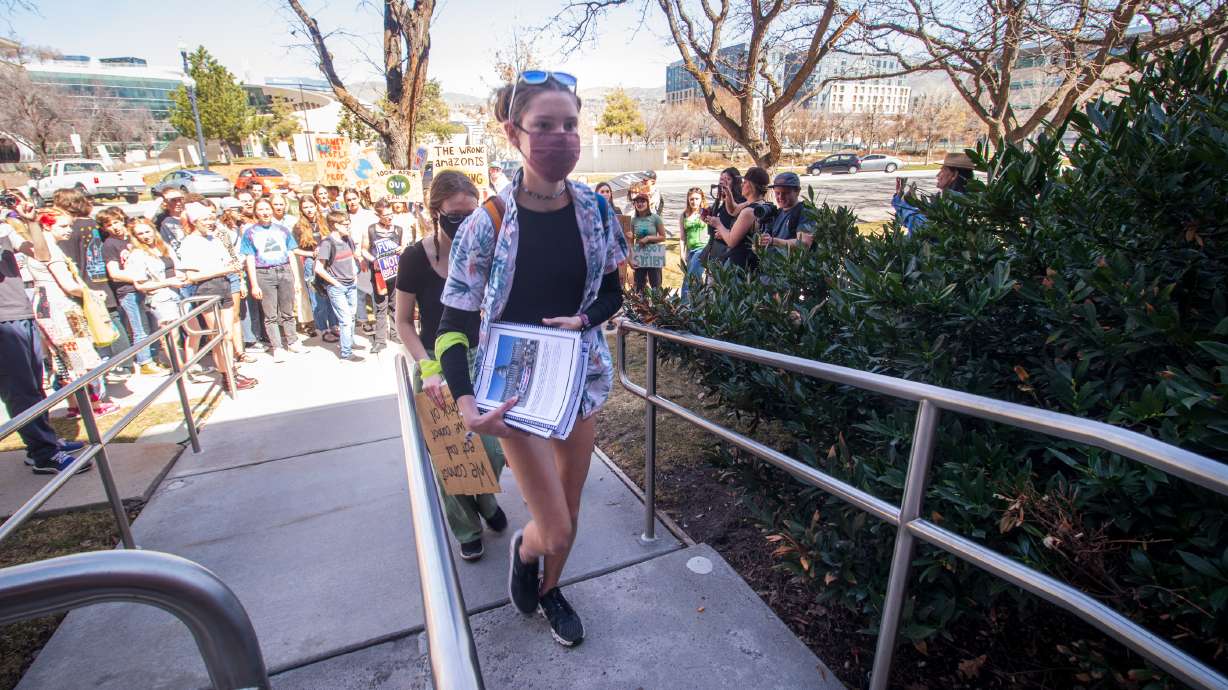Estimated read time: 5-6 minutes
This archived news story is available only for your personal, non-commercial use. Information in the story may be outdated or superseded by additional information. Reading or replaying the story in its archived form does not constitute a republication of the story.
SALT LAKE CITY — Natalie Roberts walked around the Utah State Board of Education building Friday afternoon with a stack of reports and a letter signed by students regarding how climate change is taught in Utah schools.
Ava Curtis and Mandy Merrill, both seniors at Taylorsville High School, flanked the West High School freshman as all three trotted into the building and asked to see State Superintendent of Public Instruction Syndee Dickson. At the same time, a group of a few dozen students and young adults holding signs saying, "We need a solution, not pollution," and "Let our voices be heard," alternated between climate-related chants and singing John Lennon and Plastic Ono Band's "Give Peace a Chance."
Dickson wasn't available, so there was no real confrontation or conservation. Curtis, Merrill and Roberts left the letter and a copy of the latest Intergovernmental Panel on Climate Change report with another staff member then joined the rest of the group as they marched up to the Utah State Capitol as a part of the nationwide 2022 Global Climate Strike.
Friday's march wasn't the first of its kind.
Students have walked out in protest for the past few years, since the first climate strike in 2019; there was a large event in September, too. However, this event featured a new target: education — in addition to demanding change from state leaders, promoting policies that help reduce the consumption of carbon and other greenhouse gases that are blamed for changing the climate.
"It's really important that we have education for our future," Roberts said. "We need to have education on how to live more sustainably and how to deal with the problems we see in our future."
It's why protesters took a detour southeast from the usual meeting spot of Washington Square Park in Salt Lake City this time around. They walked to the Utah State Board of Education offices a few blocks away, where Roberts, Curtis and Merrill handed over the report on global climate change and the letter with changes they'd like to see in school curriculums.
The letter argues that schools should be set up to teach students about the issues that matter in their future. They say "proper climate education" is important because current and future students stand to inherit growing climate problems, especially those written by global scientists in the report.
"We're trying to focus on education more, currently, because we believe that education will be the most impactful thing for our future," Curtis said.
We have to take actions like strikes and rallies in order to express our opinions and be able to get them out into the public.
–Natalie Roberts, freshman at West High School
A spokesman for the state school board declined to comment on the letter, as he hadn't seen it. However, he told KSL.com that the state's science and engineering education standards have been updated in recent years, in 2015 and 2019.
Students first learn about the climate and its importance, as well as weather-related hazards, in sixth grade. It gives them a "deeper scientific understanding" for global weather and climate patterns. This is also when they learn about the impacts of greenhouse gases on climate and weather.
In eighth grade, students start to "analyze for the factors that change global temperatures and regional climates and the effects of natural hazards that may occur due to these changes," according to existing curriculum descriptions. High school biology and earth science courses take this education further, including further analysis and finding solutions to reduce human impacts on the environment.
The board also touts that Utah eighth-graders had the top science scores in the nation, according to a 2015 national report card.
But Curtis contends that's not the education she's experienced. She said there was an environmental science course offered at her school, but she said it was discontinued last year; another course does teach some of the issues, but it's located off-campus. All three girls participated in student-formed groups on the matter in their free time, instead.

To that end, Merrill said she probably would not know as much as she does now had she not befriended Curtis. Her interest in the issue started with her curiosity of why the sky around her looked the way it did during pollutant-heavy inversions and why there were certain days children couldn't play outside. The group she's in helped answer her questions and addressed other climate-related concerns.
The groups haven't only marched since they were formed in recent years. They also speak at local school district board meetings — and not just about climate change, but about more sustainable energy practices.
"We are the future of our world and if we educate the youth now, we can make an impact," Merrill said.
They hope today's letter fosters future discussions about education, as well.
The groups behind the student protests expect to have more events in the future. Roberts says those are really the only options most students like her have at the moment because of their ages.
"When faced with these issues, we can't state our opinions properly because we can't vote," she said. "We have to take actions like strikes and rallies in order to express our opinions and be able to get them out into the public."










